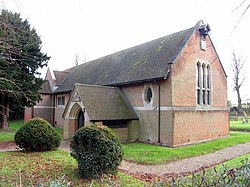Woolmer Green
| Woolmer Green | |
| Hertfordshire | |
|---|---|
 St Michael, Woolmer Green | |
| Location | |
| Grid reference: | TL253186 |
| Location: | 51°51’8"N, 0°10’48"W |
| Data | |
| Population: | 1,429 (2007 est.) |
| Post town: | Knebworth |
| Postcode: | SG3 |
| Dialling code: | 01438 |
| Local Government | |
| Council: | Welwyn Hatfield |
| Parliamentary constituency: |
Welwyn Hatfield |
Woolmer Green is a small village in Hertfordshire, found between the villages of Welwyn and Knebworth.
The village is at the meeting of ancient roads, and many Roman artefacts have been found in the surrounding area. A Roman bath house has been excavated at nearby Welwyn. Woolmer Green itself is at the junction of the old Great North Road and another Roam route, Stane Street running from St Albans. The route of this road runs across the parish along the path of Robbery Bottom Lane, continuing on as a public bridleway to Datchworth and then Braughing, on its eventual way to another major Roman town, Colchester.
St Michael & All Angels Church
The village had no church until the nineteenth century, though from 1878 Sunday services were held in the school.
Lord Lytton presented the Church with the plot of land and funds were raised for the new church. The result was St Michael and All Angels, designed by Robert Weir Schultz in a modest Arts and Crafts style. The foundation stone was laid in September 1899 by Lady Lytton, and in 3 November 1900 it was consecrated.
The church screen is a significant example of late Arts-and-Crafts design and carving. It is said that the school bell was bought for the church in 1931 at a cost of £10.
History
Thomas de Wolvesmere is recorded as having lived in a dwelling here in 1297, and his name is considered to have led to the current name of the village.
Woolmer Green is in the midst of things; in the Middle Ages part of Woolmer Green was in Mardleybury Manor, part in Rectory Manor, with the northern part owing allegiance to Broadwater Manor or Knebworth. Things have not changed; the village is still at the point where three local government districts meet.
Apart from the trade generated by travellers, life in Woolmer Green was agricultural and feudal until the middle of the nineteenth century. Things started to change, however, when the railway arrived in 1850 (although the nearby station in Knebworth was not opened until 1884 after intervention from Viscount Knebworth). The village school, which was opened a few years after this, obtained much funding from the railway.
In 1863, only a gunsmith and a shoemaker were listed in the trade directory. By 1898, when the population of Woolmer Green stood at 363 and that of Knebworth at 382, there were five shops including two beer retailers; no mention in the trade directory of the many ‘front room shops’! This level of service persisted until recent years with a general store and Post Office, a baker, a small supermarket and a butcher. Sadly these have all now closed. The former Post office was later used as a hair salon and most recently a furniture shop which was opened in June 2010.
The Great North Road, forming the village's main road, was frequented by drovers driving cattle and sheep ‘on the hoof’ to London markets. The area around Knebworth and Woolmer Green provided what was probably the last overnight stop for the animals and their drovers before they reached London.
During the 20th century the village became a popular destination for tourists travelling to and from London. One of the sights of the village was the cottage of Harry McDonald, who for many years adorned both the cottage and garden with intricate carvings of animals and other objects. He became famous as the Woodcarver of Woolmer Green. Sadly The Woodcarvers Cottage, as it came to be known, was demolished after his death.
Woolmer Green Village Hall
The parish has an excellent modern Village Hall and adjoining sports field which are very actively used by the community. The hall was opened in November 1990 by local celebrity Barry Norman and is licensed for wedding ceremonies. The Village Hall is sometimes used for Fundraising Events.
Outside links
| ("Wikimedia Commons" has material about Woolmer Green) |